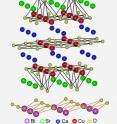Roller coaster superconductivity discovered
Superconductors are more than 150 times more efficient at carrying electricity than copper wires. However, to attain the superconducting state, these materials have to be cooled below an extremely low, so-called transition temperature, at which point normal electrical resistance disappears. Developing superconductors with higher transition temperatures is one of physics' greatest quests. Now, researchers at the Carnegie Institution's Geophysical Laboratory, with colleagues,* have unexpectedly found that the transition temperature can be induced under two different intense pressures in a three-layered bismuth oxide crystal referred to as "Bi2223." The higher pressure produces the higher transition temperature. They believe this unusual two-step phenomena comes from competition of electronic behavior in different kinds of copper-oxygen layers in the crystal. The work is published in the August 19, 2010, issue of Nature. Until now, copper-laden materials called cuprates have been the only superconductors whose transition temperatures are higher than the liquid nitrogen boiling point at -321°F (77 K). Whether researchers can make transition temperatures higher in such materials remains a challenge.
"Bi2223 is like a layered cake," explained lead author Xiao-Jia Chen at Carnegie. "On the top and bottom there are insulating bismuth-oxide layers. On the inside of those, come layers of strontium oxide. Next, are layers of copper oxide, then calcium, and finally the middle is another copper-oxide layer. Interestingly, the outermost and inner layers of copper oxide have different physical properties resulting in an imbalance of electric charge between the layers."
One way scientists have found to increase the transition temperature of superconducting materials is to "dope" them by adding charged particles.
Under normal pressure, the optimally doped Bi2223's transition temperature is -265°F (108K). The scientists subjected doped crystals of the material to a range of pressures up to 359,000 times the atmospheric pressure at sea level (36.4 Giga Pascal), the highest pressure yet for magnetic measurements in cuprate superconductors. The first higher transition temperature happened at 100,666 atmospheres (10.2 GPa).
"After that, increasing pressures ended up with lower transition temperatures," remarked Chen. "Then to our complete surprise at about 237,000 atmospheres (24 GPa) the superconducting state reappeared. Under even more pressure, 359,000 atmospheres, the transition temperature rose to -215°F (136K). That was the highest pressure our measuring system could detect."
Other research has shown that some multilayered superconducting materials like this one exhibit different electronic and vibrational behaviors in different layers. The researchers think that 237,000 atmospheres might be a critical point where pressure suppresses one behavior and enhances superconductivity.
"The finding gives new perspectives on making higher transition temperature in multilayer cuprate superconductors. The research may offer a promising way of designing and engineering superconductors with much higher transition temperatures at ambient conditions," concluded coauthor Viktor Struzhkin also of Carnegie.
Source: Carnegie Institution
Other sources
- Roller coaster superconductivity discoveredfrom Science DailyWed, 18 Aug 2010, 19:28:25 UTC
- Roller coaster superconductivity discoveredfrom PhysorgWed, 18 Aug 2010, 17:21:11 UTC
